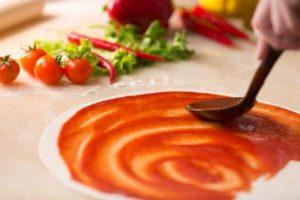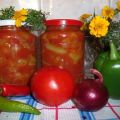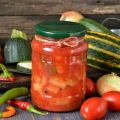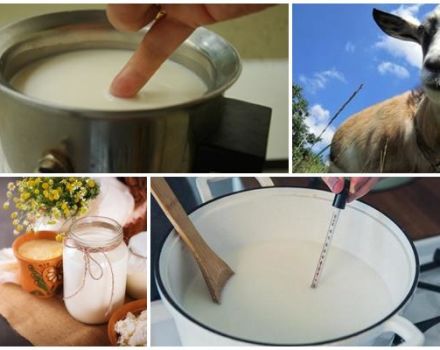Simple recipes for preparing lecho from bell pepper for the winter with tomato paste
Almost every recipe for lecho with tomato paste and bell peppers does not require a lot of preparation time. Among themselves, the options differ in the composition of the products and the method of processing conservation: some provide for sealing cans without sterilization, in others containers filled with salad must be sterilized, and only then sealed. But all the proposed methods have one thing in common: taste, aroma and beautiful color of the salad.
Classic recipe
Harvesting bell peppers for the winter in the classic way will please housewives who do not want to spend a lot of time processing tomatoes. Tomato paste is used instead of fresh tomatoes. The pickled pepper tastes just amazing. Some people call this method "lazy": with proper skill, it takes about 30 minutes to prepare canning, not counting the time spent on preparing vegetables. All the ingredients for preservation can be bought on the market, and if you have vegetables from your garden, it is even better.
A set of products for 3 liters of salad:
- lettuce red or yellow pepper, with thick walls - 2 kg;
- tomato paste - 350 g;
- table vinegar 9% - 100 ml;
- lean oil (preferably unrefined) - 200 ml;
- filtered or settled water - 600 ml;
- granulated sugar - 150 g;
- fine salt - 1 tbsp. the spoon.
You can use coarse salt, but you need to take a little more of it.
The fruits of the pepper are washed, cut lengthwise into 2 parts and the seed chamber is removed. They are chopped into large strips, trying to make them long: in canned form, such a cut looks very beautiful. Pour water into the dishes and put tomato paste. Pour sugar and salt, dissolve, immediately after that add oil.
If someone does not like the smell of unrefined oil, you can use deodorized oil, but then the taste and aroma will not be the same as in the original recipe for pepper lecho for the winter.
Mix everything, spread pepper and cook for 18 - 20 minutes.
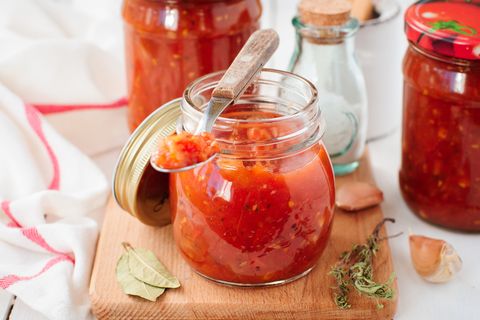
The mass needs to be stirred all the time so that it does not burn. At the very end, pour vinegar, stir again, let it boil and turn it off. Lecho is packed in hot containers. The cans must first be steamed over the kettle or in the oven, and the metal lids must be dipped in boiling water for a few seconds.
The final stage: preserve with a seaming key. Alternatively, screw caps (twist-off system). In both cases, the salad keeps well.
With fresh tomatoes
For a pepper lecho with tomato paste, you need to take fresh tomatoes, peel them and grind them. The resulting mass is put on fire and boiled until tender. Some housewives remove the seeds, but this is not necessary. Having prepared the rest of the ingredients and containers, you can start preserving lecho for the winter.
Product set:
- thick fresh tomato paste - 1 liter jar;
- salad pepper (preferably fleshy) - 2 kg;
- spring or well water - 2 l;
- garlic - 5 large cloves;
- granulated sugar - 195 g;
- salt - 90 g;
- lean oil - 310 g;
- white onion - 750 g;
- carrots - 750 g;
- acetic acid - 2 tbsp. l.
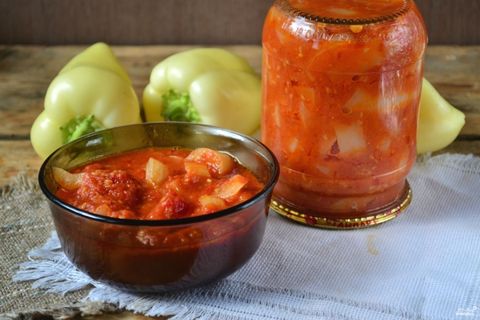
When canned, thick-walled red or yellow peppers are especially tasty and beautiful, but if not, any will do.
Treatment
Water is added to the thick tomato paste to form a liquid consistency. Pour the mass into a large saucepan, salt, add sugar and coarsely grated carrots. Bring to a boil over high heat, then simmer over low for 10 minutes. At this time, the onion and pepper are cut in half rings, they are brought to the tomato mass, they wait until it boils, and again they are cooked over low heat.
After 20 minutes, add finely chopped garlic, pour in oil and vinegar, boil for half an hour. They are laid out in prepared jars, covered with lids and sterilized for 15 minutes, after which they are sealed. Ready peppers in tomato sauce are left in the kitchen until they cool down, then taken to the cellar for storage. Similarly, lecho is made from bell pepper with tomato juice.
With young eggplants
The recipe will help out if the "blue" ones are good, and all the traditional snacks from them are tired. Eggplants need to be prepared in a special way: cut the stalks, cut into circles and put on a dish, sprinkle with a little salt. In this form, the eggplant is left for 30 minutes, while the rest of the ingredients are prepared.
After half an hour, the eggplant slices are squeezed out, the juice is poured. You cannot keep it in salt for longer than 30 minutes, otherwise the lecho with tomato paste will turn out to be too salty for the winter.
Product set:
- young eggplants - 1 kg;
- salad pepper - 1 kg;
- tomato paste - 500 g;
- onions - 500 g;
- granulated sugar - 3 tbsp. spoons;
- water - 500 ml;
- rock salt - 1 tbsp. the spoon.
In this version of the preparation for the winter, the fruits of the pepper are carefully cut into 2 parts lengthwise, the seed chamber is taken out, cut into cubes 3-4 cm long. The bulb is freed from the husk, chopped into half rings or straws. The tomato paste is mixed with water, the mass is poured into a large saucepan, salted, sugar is added, stirred until the grains are dissolved and allowed to boil.
Put the prepared onion into the boiling liquid, cook for 4 minutes, then put the pieces of eggplant in the same place and stew for 11 - 12 minutes over low heat. Add lettuce and cook for another half hour while stirring. Then add vinegar, let it boil again, boil for 2 - 3 minutes and immediately pack it into jars. You can close it with ordinary metal or screw caps.
The sealed canned food is turned over to make sure it is sealed and left on the table. Cover with a blanket or sweatshirt to extend the cooling time. When the conservation cools down, and this will happen in about a day, it can be taken to the cellar. Preparing pepper in tomato paste for the winter with eggplant is not at all difficult, so the recipe is just a godsend for those who like original food combinations. Enjoy cooking! Instead of eggplant, you can use young zucchini, zucchini is better, but another variety will do.
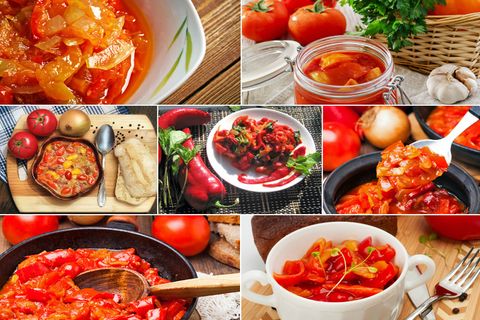
Cooking a snack with zucchini is no different, only it is advisable to take red or yellow peppers to make the lecho bright. You do not need to peel the zucchini.
Onion and carrot recipe
Assorted Lecho is a tasty and healthy preparation rich in various vitamins. It is not difficult to cook it, so even a novice hostess can handle it. According to this recipe, it is worth making lecho from bell pepper with tomato paste for the whole winter: by spring there is nothing left.
Product set:
- salad peppers with thick walls - 1 kg;
- carrots - 400 g;
- white turnip onions - 0.3 kg;
- garlic - 1 large head;
- tomato paste - 500 g;
- coarse salt - 50 g;
- lean oil (refined) - 130 ml;
- 9% vinegar - 50 ml;
- granulated sugar - 10 g.
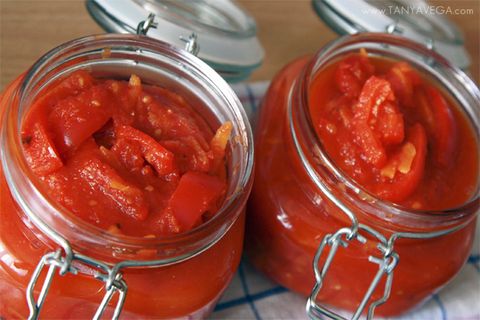
To make lecho for the winter with tomato juice, you need to take it twice as much as paste.
Pickling process
The cans are steamed and placed on the table upside down, the lids are dipped in boiling water for a few seconds, taken out and folded side by side.
The fruits of the pepper are washed, cut in half lengthwise, and the seed nest is pulled out. Pepper is chopped into large strips along or across. Carrots are washed, scraped, washed again, then finely chopped or chopped on a grater with large holes to make straws. Onions are cut in half rings or thin strips, as you like.
The garlic is crushed with a garlic press. If grated tomatoes are used instead of tomato paste, they are boiled until thick.
Oil is poured into a rooster or rooster, heated and put onions. It needs to be kept on fire for 4 - 5 minutes, avoiding frying, so that it is sautéed, but does not change color. Carrots, garlic and pepper are added to onions. Everything is mixed and stewed for about 10 minutes. Dilute tomato paste with water and pour this mixture into vegetables. A salad with tomato juice for the winter is prepared in the same way, only water is not added.
Cook for another 40 minutes with constant stirring. Then put vinegar, boil the mixture for 3 minutes, turn off the stove and immediately pack the salad into jars. They are sealed with screw caps or ordinary ones, using a seaming key, and the jars are left at room temperature until they cool completely, turning them upside down and wrapped in a blanket or warm clothes. Then they are transferred to the basement, where the workpiece is successfully stored all winter.
